This report is part of a series covering cryptocurrency investing. This is not meant to be investment advice, but covers some of the performance, trends, opportunities and future of cryptocurrency.
With the total number of cryptocurrencies and digital assets on exchanges skyrocketing from 617 to 1,335 over the course of the year, 2017 has been dubbed the “year of the cryptocurrency.”[i] The market capitalization, investor appetite, and institutional coverage for cryptocurrencies have all jumped exponentially. This article will focus on the recent performance of the cryptocurrency industry, key factors driving and restraining growth, and its outlook over the next five years.
Contents
Industry Performance
Market Size & Volatility
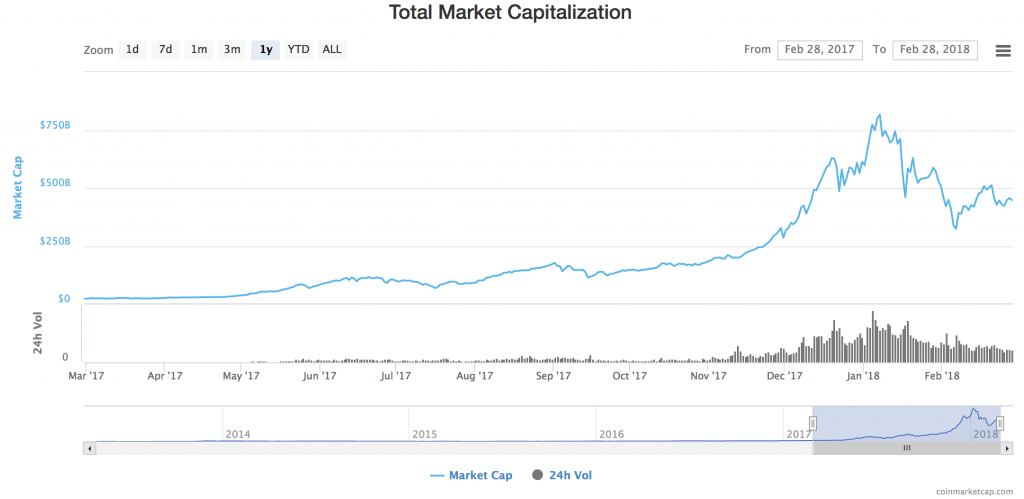
Estimating the exact market size can be difficult of any industry, but particularly the cryptocurrency industry due to the massive volatility in prices over short periods of time. As of December 1, 2017, the total market capitalization of the cryptocurrency market was $326.7B. By January 1 of this year, the cryptocurrency market cap had increased to $629.5B. At the writing of this article (February 28, 2018), the market cap settled at $447.9B.[ii]
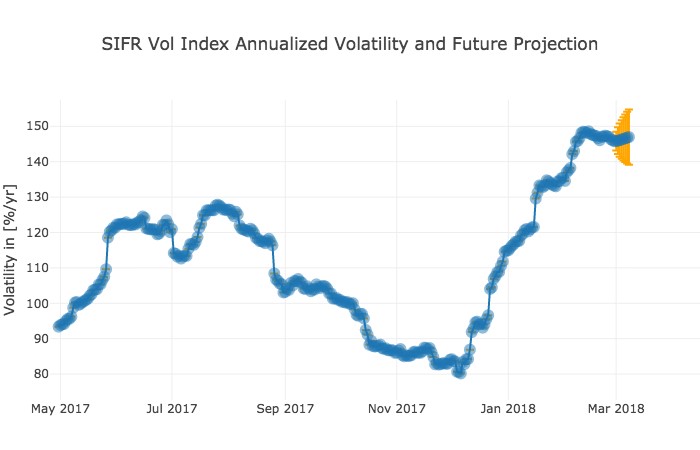
| Source: SIFR |
The volatility of the crypto market spent all of 2017 above 80% annualized volatility level with a large portion of the year consistently above 100% volatility and peaking in February 2018 at 148% volatility.[iii] These extremely high levels are unheard for assets traded in volumes as high as cryptocurrencies in 2017. They are also especially high when compared to the rest of the US stock market, which in 2017 experienced one of the least volatile years on record.[iv]
Astronomical Growth Rates
In 2017, the cryptocurrency industry saw record-breaking growth rates in the number of market participants and market capitalization. The total number of cryptocurrencies and digital assets on exchanges soared by 216%, from 617 to 1,335, and currently stands at 1,531.[v][vi] Total market capitalization increased by 3,363% in 2017, with Bitcoin’s market cap jumping 1,364% and the Altcoin side shooting 16,695%.[vii] Altcoin describes all cryptocurrencies or digital assets other than Bitcoin.
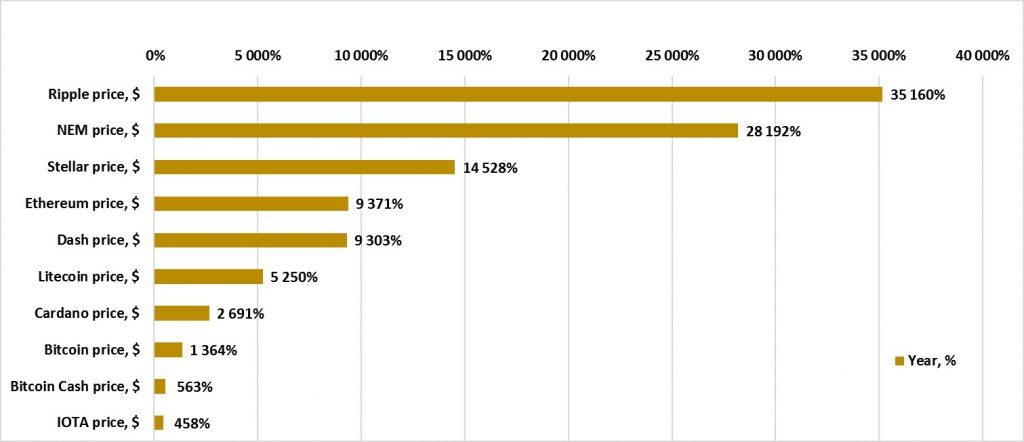
| Source: CoinSpeaker |
| Record growth in prices of the Top 10 cryptocurrencies by capitalization during 2017 (USD), %. |
The majority of analysts are bullish on the continued growth of the crypto market, although it is difficult to form any consensus about growth rates. Because of its vast application and advantages to traditional currencies, most analysts agree that the growth in the crypto market seen thus far is only the beginning of a long exponential curve.[viii] The highest estimates from bullish investors put the 2018 total market cap of crypto assets at $2T[ix], and the Bitcoin price at $1M by 2020.[x] More conservative estimates still predict a bitcoin price of $100,000 by 2022.[xi]
ICO’s (Initial Coin Offerings)
Initial Coin Offerings (ICO) are a new kind of financial transaction, used to raise funds for a new cryptocurrency or other digital asset. Investors pay using cash or another cryptocurrency and are given a percentage of the new cryptocurrency in return. As cryptocurrencies become a more stable asset class, ICO’s are becoming a popular means of raising money and avoiding the arduous regulation surrounding the capital raising process.[xii]
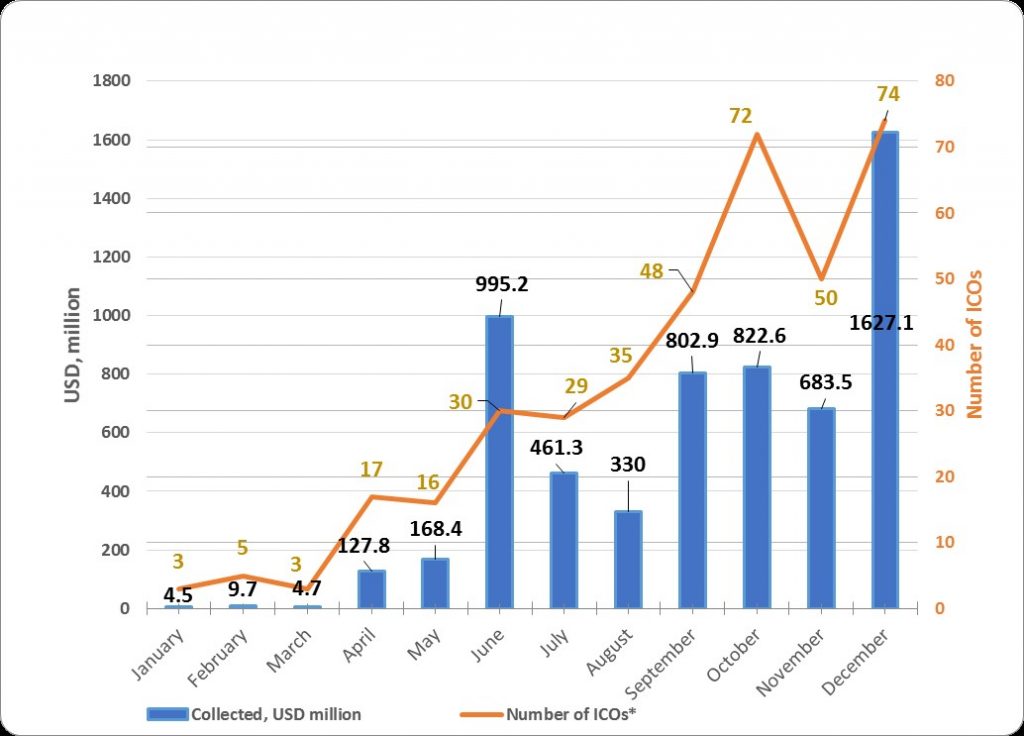
| ICO Market, Funds Invested & Number of ICO’s, 2017 |
| Source: CoinSpeaker |
In 2017, as the number of cryptocurrencies more than doubled, the ICO market saw equally historic activity levels. In total, over $6B was raised in more than 382 ICO’s over the course of the year, with June and December recording the highest individual months.[xiii] With the rising success and popularity of Bitcoin and other cryptocurrencies, this hot ICO market is one clear piece of evidence that investors have become willing and anxious to allocate more capital into this new asset class.
Market Share Concentration
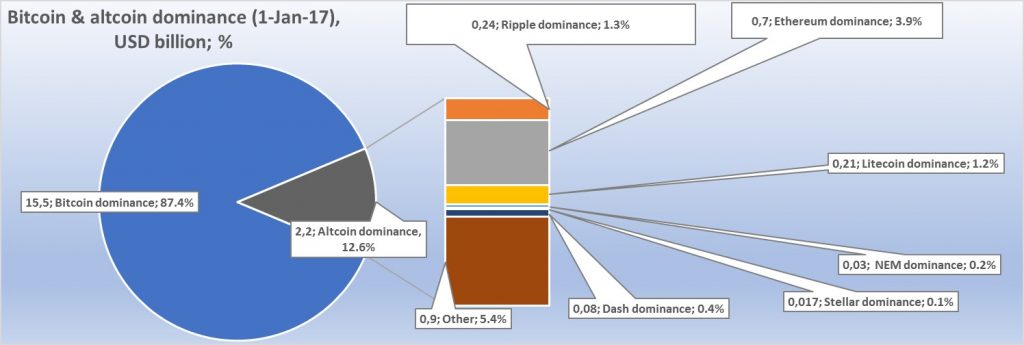
| Source: CoinSpeaker |
This was also a transformative year in the cryptocurrency market in terms of market share concentration. At the beginning of the year, Bitcoin held 87.4% of all capital invested in the crypto market. As its popularity came into the spotlight, and cryptocurrencies became more mainstream, over 914 new cryptocurrencies hit the market in 2017 alone. As a result, Bitcoin’s market share was reduced to 38.6% by year end.[xiv]

| Source: CoinSpeaker |
Growth Drivers
Economic Expansion
One unseen, but important factor in the rise of the cryptocurrency market is the recent economic expansion. Noting the history of cryptocurrencies – with blockchain and Bitcoin coming into existence in 2009 and Bitcoin’s subsequent upsurge after 2013 – it is easy to see that as market fears calmed after the 2008 recession, investors’ appetite for risk returned to pre-recession levels. And as the stock market experienced an almost all-time record year in 2017, investor confidence rode to historic highs as well – a perfect environment for the growth of a new type of risky investment asset.
Blockchain Technology
Blockchain has taken the technology world by storm with the rise of Bitcoin. Prior to the advent of blockchain technology, bitcoin and the rest of the cryptocurrency world were virtually worthless. Blockchain technology is simply a ledger that holds a sequence of transactions that update automatically across a series of independent databases located in multiple geographic locations. This technology has profound implications for many industries but has already had rapid effects on the currency and financial technology space. The increased efficiency, decreased transaction costs, and heightened security that blockchain provides gives cryptocurrencies nearly all of their value. It allows for users to create unforgeable and verifiable transactions, while avoiding the digital fees usually enacted by banks for online transactions. IBISWorld reports an expected 7.3% increase over the next five years to 2022 in services conducted online in connection with advances in blockchain technology.[xv] Since its introduction in 2008, the value of cryptocurrencies has grown at astronomical rates, which explains the exuberance and entrance into reverse mergers for digital assets. That growth and the integration of blockchain the financial sector is expected to continue.
Investor Appetite
One of the major drivers of the growth seen in the crypto market has simply been a large increase in investor appetite. Over the course 2017, cryptocurrencies received a large amount of attention from investment and government institutions which legitimized them as investment assets. In February and April, Japan issued laws requiring cryptocurrencies to register with the financial services agency – a step towards the legalization of cryptocurrencies. In June, Goldman Sachs announced that due to popular demand, their markets division would begin covering Bitcoin. And at the end of October, the CME announced it would begin issuing Bitcoin derivatives.[xvi] All of these events, among others, showcase the pent up investor demand for cryptocurrencies.
- Attractive Investment Features
- Decentralized: Monetary policy dictated by central banks can cause devaluation of centralized currencies. Whereas cryptocurrencies are not controlled by any government and therefore are not subject to the will of central banks and are only controlled by market dynamics.
- Secure: Cryptocurrencies are, by definition, secure. The decentralized nature of blockchain technology allows for unforgeable, verifiable transactions to take place across several geographic locations. This calms many of the fears critics have raised for the past decade about cryptocurrencies.
- Completely Digital: Because cryptocurrencies are completely virtual, there are practically no transportation costs whatsoever, nor transaction costs. Whereas even online banks may charge for transaction fees, the digital nature of cryptocurrencies significantly decreases the cost of digital transactions.
- Growth in Value: With the rise of technology capable of using cryptocurrencies, the market has shown that there is a large desire for digital currencies. As a result, cryptocurrencies have a become a valuable method for holding and appreciating wealth.
- Untapped Uses: Investors are seeing that this is only the beginning of the upturn for cryptocurrencies. There are several applications that are either beginning to be or that have yet to be explored. These include smart contracts, ESOP’s, capital raising and more.
Growth Restraints
Regulation
Regulator treatment of cryptocurrencies is not yet completely decided, however uncertainty over the future regulations to be placed on the investing and trading in the crypto market is a major limit on growth. In fact, a lack of regulatory oversight scares many would-be investors away and lends to the stereotype that cryptocurrencies are used only by gangs and criminals looking to launder money. Many investors are nervous that governments are looking to completely ban the use of cryptocurrencies as has already taken place in some countries.[xvii] Additionally, as regulators around the world have seen the appreciation in the crypto market and hope to capitalize on its growth, questions have been raised about the tax treatment of cryptocurrencies.[xviii] This year, the SEC disapproved of a Bitcoin ETF and declared tokens were “securities” thereby restricting their legal use to that of a normal security. Later in the year, the Chinese Central Bank declared that ICO’s were illegal.[xix] The crypto market has proven to be even more sensitive to news on regulation and government treatment than traditional stock exchanges. This trend of sensitivity, combined with continued uncertainty, will curb growth as much of the developed world is still trying to understand and institutionalize cryptocurrencies.
Volatility
As previously noted, the crypto market has seen extreme levels of volatility over the course of its ascension. Although certain investors would view this trend positively, there is a large portion of the world’s capital that is off-limits to cryptocurrencies because of their high volatility. Cryptocurrencies are so volatile for many reasons including:
- No Intrinsic Value
- Lack of Regulatory Oversight
- Lack of Institutional Capital
- Thin Order Books
Many of these are characteristic of immature markets and should be resolved over the course of the next decade as the market ages. But until these issues are solidified, volatility will continue to reign.
Cybercrime
Lastly, the growth of the cryptocurrency market is limited to the degree to which it can assure investors that their money will be safe. This seems to be traditional investing logic, but with the novel nature of cryptocurrencies, investors are especially cautious about the safety of their capital. Despite the security provided by blockchain technology, the crypto world is still completely digital and therefore prone to cyber-attacks. This has already occurred several times over the past 5 years with hundreds of millions of dollars being stolen by hackers.[xx]
Outlook
The cryptocurrency market appears to be a fixture of a new era of investing. Because of the plethora of new technologies that it employs and its applications in the several industries, cryptocurrencies are expected to continue to grow and eventually stabilize. Volatility will gradually subside over the coming decade as more regulation, a greater diversity of investors, and improved security measures enter the market.[xxi] Because of this, there will be a continued flow of capital into the crypto market as long term investors begin to invest and build a solid foundation for long term market growth.
Sources
[i] Dmitrii Kornilov et al., Cryptocurrency and ICO Market Overview for 2017 – CoinSpeaker CoinSpeaker (2018), https://www.coinspeaker.com/2018/01/04/cryptocurrency-ico-market-overview-2017/ (last visited Feb 24, 2018).
[ii] Global Charts, CoinMarketCap, https://coinmarketcap.com/charts/ (last visited Feb 28, 2018).
[iii] By, Cryptocurrency Volatility Index Sifr Data LLC (2018), https://www.sifrdata.com/cryptocurrency-volatility-index/ (last visited Feb 28, 2018).
[iv] S&P 500 Volatility In 2017 Was The Lowest In History (SPY), Yahoo! Finance (2017), https://finance.yahoo.com/news/p-500-volatility-2017-lowest-113321953.html (last visited Feb 28, 2018). “The maximum level reached by the VIX in 2017 was 17.28. That is the lowest maximum level attained in any year since inception — and 60% lower than the ‘average yearly max’.”
[v] Dmitrii Kornilov et al., Cryptocurrency and ICO Market Overview for 2017 – CoinSpeaker CoinSpeaker (2018), https://www.coinspeaker.com/2018/01/04/cryptocurrency-ico-market-overview-2017/ (last visited Feb 24, 2018).
[vi] Global Charts, CoinMarketCap, https://coinmarketcap.com/charts/ (last visited Feb 28, 2018).
[vii] Dmitrii Kornilov et al., Cryptocurrency and ICO Market Overview for 2017 – CoinSpeaker CoinSpeaker (2018), https://www.coinspeaker.com/2018/01/04/cryptocurrency-ico-market-overview-2017/ (last visited Feb 24, 2018).
[viii] Noah Jessop, 10 Predictions For The Next 5 Years Of Crypto Forbes (2017), https://www.forbes.com/sites/noahjessop/2017/12/01/10-predictions-for-the-next-5-years-of-crypto/#660eefb5a40d (last visited Mar 1, 2018).
[ix] Josiah Wilmoth, Cryptocurrency Market Cap to Reach $2 Trillion in 2018: Mike NovogratzCCN.com (2017), https://www.ccn.com/cryptocurrency-market-cap-to-reach-2-trillion-in-2018-mike-novogratz/ (last visited Mar 1, 2018).
[x] John Potter, Bitcoin Price Predictions for 2018: An Expert Roundup 99 Bitcoins (2108), https://99bitcoins.com/bitcoin-price-predictions-2018/ (last visited Mar 1, 2018).
[xi] Noah Jessop, 10 Predictions For The Next 5 Years Of Crypto Forbes (2017), https://www.forbes.com/sites/noahjessop/2017/12/01/10-predictions-for-the-next-5-years-of-crypto/#660eefb5a40d (last visited Mar 1, 2018).
[xii] Osi Momoh, Initial Coin Offering (ICO) Investopedia (2017), https://www.investopedia.com/terms/i/initial-coin-offering-ico.asp (last visited Mar 5, 2018).
[xiii] Dmitrii Kornilov et al., Cryptocurrency and ICO Market Overview for 2017 – CoinSpeaker CoinSpeaker (2018), https://www.coinspeaker.com/2018/01/04/cryptocurrency-ico-market-overview-2017/ (last visited Feb 24, 2018).
[xiv] Dmitrii Kornilov et al., Cryptocurrency and ICO Market Overview for 2017 – CoinSpeakerCoinSpeaker (2018), https://www.coinspeaker.com/2018/01/04/cryptocurrency-ico-market-overview-2017/ (last visited Feb 24, 2018).
[xv] Dylan Miller & Jonathan Hadad, Bit by Bit: Blockchain Takeover Media Center RSS (2017), https://www.ibisworld.com/media/2017/11/21/blockchain-technology/ (last visited Mar 5, 2018).
[xvi] Dmitrii Kornilov et al., Cryptocurrency and ICO Market Overview for 2017 – CoinSpeakerCoinSpeaker (2018), https://www.coinspeaker.com/2018/01/04/cryptocurrency-ico-market-overview-2017/ (last visited Feb 24, 2018).
[xvii] Rosie Perper, China is moving to eliminate all cryptocurrency trading with a ban on foreign exchanges Business Insider (2018), http://www.businessinsider.com/china-eliminates-all-cryptocurrency-trading-2018-2 (last visited Mar 5, 2018).
[xviii] Joe Barnes and Albert Evans, Bitcoin price WARNING: Cryptocurrency volatility ‘isn’t going away anytime soon Express.co.uk (2018), https://www.express.co.uk/finance/city/910448/bitcoin-price-USD-news-value-BTC-Ripple-ethereum-cryptocurrency-buy (last visited Mar 5, 2018).
[xix] Dmitrii Kornilov et al., Cryptocurrency and ICO Market Overview for 2017 – CoinSpeakerCoinSpeaker (2018), https://www.coinspeaker.com/2018/01/04/cryptocurrency-ico-market-overview-2017/ (last visited Feb 24, 2018).
[xx] Chukwudi Ibe @nitrospawngmail-com et al., 5 High Profile Cryptocurrency Hacks – (Updated)Blockgeeks (2017), https://blockgeeks.com/guides/cryptocurrency-hacks/ (last visited Mar 5, 2018).
[xxi] Arthur Iinuma, Why Is the Cryptocurrency Market So Volatile: Expert Take Cointelegraph(2018), https://cointelegraph.com/news/why-is-the-cryptocurrency-market-so-volatile-expert-take (last visited Mar 5, 2018).
William Montgomery contributed to this report.
- How to Offset W-2 Income Taxes by Investing in Real Estate - July 19, 2024
- How to Invest in Real Estate Sight Unseen - July 16, 2024
- 19 Reasons Foreigners Should Invest in US Single-Family Real Estate - July 11, 2024

